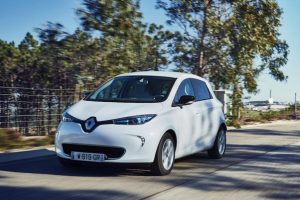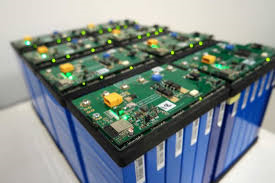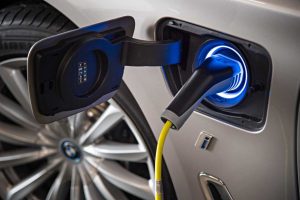First of all, let us start from several observations that the IEA has just made in two recent reports (IEA, Tracking Clean Energy Progress and Global EV Outlook 2019, May 2019, www.eia.org). Road traffic is the source of 24% of global CO2 emissions and in France it accounts for 28% of greenhouse gas emissions (passenger cars contributing to 53% of global transport modes emissions, trucks vehicles to 21.3%) and the reduction of these emissions on a planetary scale rests on the development of the electric mobility accompanied by the « decarbonization » of the electrical production. The first encouraging news is the net slowdown of CO2 emissions by the transport sector in 2018: their growth was « only » 0.6% last year (instead of 1.6% per year in recent years). The emissions from road vehicles (cars, buses, trucks) have increased only slightly (accounting for three-quarters of the total emissions of the transport sector) while those of aviation and shipping continue to grow. The IEA attributes this slight lowering of CO2 emissions by road transport to electrification of cars, a better use of biofuels and a 2.8% reduction in the energy intensity of the sector. IEA notices a sharp increase of electric cars (fully electric and hybrid) sales. The market has indeed taken  off : 2 million electric passenger cars were sold worldwide in 2018 (an increase of 64%, including 1.2 million vehicles with rechargeable batteries) with a 5.1 million vehicles global fleet. In France the progression was lower (25% or 45,000 units including 14,500 plug-in hybrids). China accounted for about 55% of the global market last year while Norway’s electric cars sales accounted for 46% of total sales in this country. The world’s electric car parks are divided into three blocks: China with 2.3 million vehicles, the EU with 1.2 million and the United States with 1.1 million. Light commercial vehicle sales took off more slowly (250,000 units in 2018) and truck sales remained marginal (1,000 to 2,000 vehicles).
off : 2 million electric passenger cars were sold worldwide in 2018 (an increase of 64%, including 1.2 million vehicles with rechargeable batteries) with a 5.1 million vehicles global fleet. In France the progression was lower (25% or 45,000 units including 14,500 plug-in hybrids). China accounted for about 55% of the global market last year while Norway’s electric cars sales accounted for 46% of total sales in this country. The world’s electric car parks are divided into three blocks: China with 2.3 million vehicles, the EU with 1.2 million and the United States with 1.1 million. Light commercial vehicle sales took off more slowly (250,000 units in 2018) and truck sales remained marginal (1,000 to 2,000 vehicles).
Although these total sales are taking off, they account for only 2.5% of global auto sales, which leads IEA updating its energy scenarios. By 2030, its « New Policies » scenario, which takes into account recent energy policies (but which does not achieve the goal of the Paris agreement to limit global warming to 2 °C), aimed at a global market of 23 million cars in 2030, and it proposes a more dynamic alternative scenario « EV 30 » in which, by 2030, this global market would represent one third of total sales, ie 43 million vehicles (with a fleet of 250 million). This objective requires a considerable technical and financial effort.
In this context what is the situation in France? In July 2017, the government’s « climate plan » set the ambitious goal of stopping the commercialization of thermal vehicles in 2040 (meanwhile trucks and buses being excepted). The Parliamentary Office for the Evaluation of Scientific and Technological Choices (OPECST in French) has published an interesting report on this issue (OPECST, Technological scenarios to achieve the goal of stopping the commercialization of thermal vehicles in 2040, March 2019, www.senat.gouv ). Its conclusions are based on three contrasting technological scenarios proposed by the CEA and the IFP Energies nouvelles for the progress of technologies, by 2040, in the field of batteries and fuel cells (with a carbon tax of € 141 / tonne CO2). Two of them are proactive: – the « Pro-Battery » scenario is based on the assumption that the use of lithium batteries will expand rapidly, with an energy density of 300 Wh /kg (150 Wh / kg in 2018), and their cost falling to € 50 / kWh (€ 230 / kWh in 2018) – the « Pro-Hydrogen » scenario assumes that the costs of hydrogen storage tanks (under high pressure) and fuel cells fall the fastest.
The three IEA scenarios lead to the same result: the total disappearance of non-hybrid thermal vehicles in 2040, associated with a very sharp drop in CO2 emissions (by a factor of five) and a marked improvement in the air quality in cities. On this basis, the OPECST concludes that the goal of completely eliminating the purely thermal motorization of passenger cars can be achieved in 2040 but that this transformation will be expensive, of the order of € 500 billion over 20 years, it supposes the maintenance by the State of a bonus for the purchase of an electric vehicle (6 000 € today), the construction of a network of electric charging stations (public and private) and for hydrogen (with a global cost between € 30.7 and € 108 billion). There is no quantitative assumption about the future of the fleet. ENEDIS (an EDF subsidiary for electricity distribution) has made scenarios by 2035 (see the report Impact of the development of clean mobility on the energy mix, by CRE, Commission de regulation de l’énergie , July 2018, www.cre.fr): a park that would be between 3.2 and 9, 6 million vehicles with electricity consumption in the range of 8 to 25 TWh compatible with current generation capacity (approximately 550 TWh).
The development of the electric car (and in the longer term that of heavy vehicles) largely depends on progress on the one hand batteries (or hydrogen fuel cells) and on the other hand charging systems. The expansion of the fleet of electric cars has launched a race for electric batteries (see Véronique Lamblin, « The race for electric batteries », October 2017, www.futuribles.com ), the lithium-ion battery is currently the workhorse of manufacturers (Renault equips its ZOE recent model with a battery that gives it a 400 km autonomy). The manufacturers have three objectives: – increase the energy density of the batteries – increase their lifetime by supporting a greater number of charge-discharge cycles – reduce their price. Builders must also consider safety conditions (avoid a fire). The long-term availability of the materials that make up the electrodes (especially lithium and cobalt) is another important parameter that must be taken into account. Progress has been slow on all three fronts. Other channels are being  considered: replacing lithium (the lightest of metals) with another metal, magnesium, sodium and zinc in particular. Lithium-air couples (lithium oxides are produced and dissociated in the battery) or zinc-air are also tested, the energy density of the first would be three to four times that of the lithium-ion battery and it would have the great advantage to avoid using cobalt for the cathode (this one is in graphite, doped with a lithium salt, which traps oxygen), the work on these batteries are still at the R & D stage but seem promising (cf. P.Papon, De nouvelles filières de batteries? Futuribles vigie, juillet 2019, www.futuribles.com ). Let us recall that the hydrogen fuel cell option, a possible path according to the OPECST, requires a production of « fuel » by electrolysis (in a station-service or on a parking lot) whose energy efficiency is less than 70 % and then the storage of hydrogen in a tank under 700 bar (a loss of 10% energy). The operation, which is complex, is not economically profitable and raises security issues that are rarely mentioned (as is the case with the OPECST report). The advantage of the hydrogen fuel cell, however, is the speed of refilling a tank.
considered: replacing lithium (the lightest of metals) with another metal, magnesium, sodium and zinc in particular. Lithium-air couples (lithium oxides are produced and dissociated in the battery) or zinc-air are also tested, the energy density of the first would be three to four times that of the lithium-ion battery and it would have the great advantage to avoid using cobalt for the cathode (this one is in graphite, doped with a lithium salt, which traps oxygen), the work on these batteries are still at the R & D stage but seem promising (cf. P.Papon, De nouvelles filières de batteries? Futuribles vigie, juillet 2019, www.futuribles.com ). Let us recall that the hydrogen fuel cell option, a possible path according to the OPECST, requires a production of « fuel » by electrolysis (in a station-service or on a parking lot) whose energy efficiency is less than 70 % and then the storage of hydrogen in a tank under 700 bar (a loss of 10% energy). The operation, which is complex, is not economically profitable and raises security issues that are rarely mentioned (as is the case with the OPECST report). The advantage of the hydrogen fuel cell, however, is the speed of refilling a tank.
The battery charging system (or of hydrogen fuel cells) is a critical point for the electric car (in 2018 there were about 240 000 public and private  charging stations in France). First of all, it is important to avoid the simultaneous recharging of batteries by vehicle owners at rush hour (at a time when solar power plants are no longer producing) because the power available on the grid would be insufficient (it would be necessary to have some GW in reserve just in case …). Installations for slow recharging are not a major problem (less than 20 kW of power is needed with an AC / DC converter). This is not the case for very fast recharges (15 minutes), power exceeding 150 kW will be essential (see IRENA, May 2019, www.irena.org ). An innovative solution has been proposed: the charge of the battery by induction, the automobile circulates on a track equipped, below the surface, with a rail with a circulating electric current which will create an electromagnetic field inducing a current in a coil in the car that will charge the battery.
charging stations in France). First of all, it is important to avoid the simultaneous recharging of batteries by vehicle owners at rush hour (at a time when solar power plants are no longer producing) because the power available on the grid would be insufficient (it would be necessary to have some GW in reserve just in case …). Installations for slow recharging are not a major problem (less than 20 kW of power is needed with an AC / DC converter). This is not the case for very fast recharges (15 minutes), power exceeding 150 kW will be essential (see IRENA, May 2019, www.irena.org ). An innovative solution has been proposed: the charge of the battery by induction, the automobile circulates on a track equipped, below the surface, with a rail with a circulating electric current which will create an electromagnetic field inducing a current in a coil in the car that will charge the battery.
As many reports, including OPECST’s one, pointed out, the electric car represents a major technical and industrial challenge because it is necessary to be prepared for the transformation of the automotive sector by avoiding, in particular, its excessive dependence on batteries  manufactured in Asia (China has half of the world market). To deal with this, Tesla invested $6 billion with Panasonic in a “Gigafactory” in Nevada to produce batteries. It is necessary to set up a European battery industry based on R&D (an « Airbus » of batteries as was recently proposed by Germany and France, which have committed to invest 2 billion euros together). Similarly, Europe’s access to « critical » metals, including lithium, cobalt and rare earths such as neodymium (for some magnets), as well as the platinum needed for fuel cells, whose reserves are limited, must be guaranteed. waiting to find them alternatives, and also prepare a recycling of batteries. All of this involves investments in Research and Development.
manufactured in Asia (China has half of the world market). To deal with this, Tesla invested $6 billion with Panasonic in a “Gigafactory” in Nevada to produce batteries. It is necessary to set up a European battery industry based on R&D (an « Airbus » of batteries as was recently proposed by Germany and France, which have committed to invest 2 billion euros together). Similarly, Europe’s access to « critical » metals, including lithium, cobalt and rare earths such as neodymium (for some magnets), as well as the platinum needed for fuel cells, whose reserves are limited, must be guaranteed. waiting to find them alternatives, and also prepare a recycling of batteries. All of this involves investments in Research and Development.
